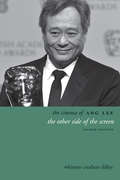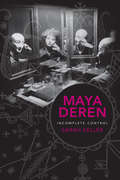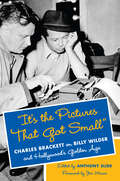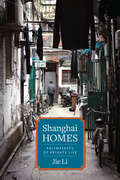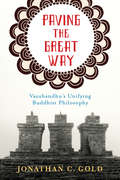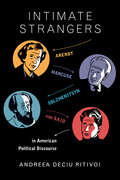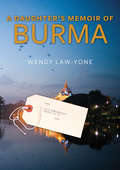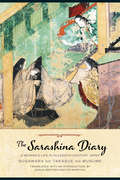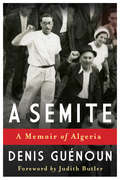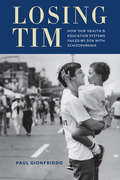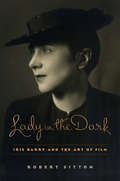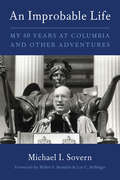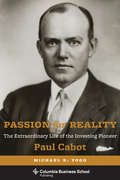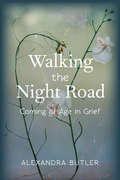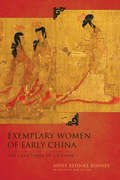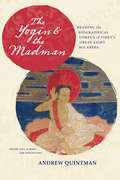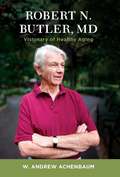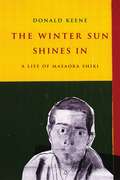- Table View
- List View
The Cinema of Ang Lee: The Other Side of the Screen (Directors' Cuts)
by Whitney Crothers DilleyBorn in Taiwan, Ang Lee is one of cinema's most versatile and daring directors. His ability to cut across cultural, national, and sexual boundaries has given him recognition in all corners of the world, the ability to work with complete artistic freedom whether inside or outside of Hollywood, and two Academy Awards for Best Director. He has won astounding critical acclaim for Crouching Tiger, Hidden Dragon (2000), which transformed the status of martial arts films across the globe, Brokeback Mountain (2005), which challenged the reception and presentation of homosexuality in mainstream cinema, and Life of Pi (2012), Lee's first use of groundbreaking 3D technology and his first foray into complex spiritual themes.In this volume, the only full-length study of Lee's work, Whitney Crothers Dilley analyzes all of his career to date: Lee's early Chinese trilogy films (including The Wedding Banquet, 1993, and Eat Drink Man Woman, 1994), period drama (Sense and Sensibility, 1995), martial arts (Crouching Tiger, Hidden Dragon, 2000), blockbusters (Hulk, 2003), and intimate portraits of wartime psychology, from the Confederate side of the Civil War (Ride with the Devil, 1999) to Japanese-occupied Shanghai (Lust/Caution, 2007). Dilley examines Lee's favored themes such as father/son relationships and intergenerational conflict in The Ice Storm (1997) and Taking Woodstock (2009). By looking at the beginnings of Lee's career, Dilley positions the filmmaker's work within the roots of the Taiwan New Cinema movement, as well as the larger context of world cinema. Using suggestive readings of both gender and identity, this new study not only provides a valuable academic resource but also an enjoyable read that uncovers the enormous appeal of this acclaimed director.
Maya Deren
by Sarah KellerAssesses both the filmmaker's completed work and her numerous unfinished projects, arguing Deren's overarching aesthetic is founded on principles of incompletion, contingency, and openness
Maya Deren: Incomplete Control (Film and Culture Series)
by Sarah KellerMaya Deren (1917–1961) was a Russian-born American filmmaker, theorist, poet, and photographer working at the forefront of the American avant-garde in the 1940s and 1950s. Influenced by Jean Cocteau and Marcel Duchamp, she is best known for her seminal film Meshes of the Afternoon (1943), a dream-like experiment with time and symbol, looped narrative and provocative imagery, setting the stage for the twentieth-century's groundbreaking aesthetic movements and films.Maya Deren assesses both the filmmaker's completed work and her numerous unfinished projects, arguing Deren's overarching aesthetic is founded on principles of incompletion, contingency, and openness. Combining the contrasting approaches of documentary, experimental, and creative film, Deren created a wholly original experience for film audiences that disrupted the subjectivity of cinema, its standards of continuity, and its dubious facility with promoting categories of realism. This critical retrospective reflects on the development of Deren's career and the productive tensions she initiated that continue to energize film.
"It's the Pictures That Got Small": Charles Brackett on Billy Wilder and Hollywood's Golden Age (Film and Culture Series)
by Anthony SlideGolden Age Hollywood screenwriter Charles Brackett was an extremely observant and perceptive chronicler of the entertainment industry during its most exciting years. He is best remembered as the writing partner of director Billy Wilder, who once referred to the pair as "the happiest couple in Hollywood," collaborating on such classics as The Lost Weekend (1945) and Sunset Blvd (1950). In this annotated collection of writings taken from dozens of Brackett's unpublished diaries, leading film historian Anthony Slide clarifies Brackett's critical contribution to Wilder's films and Hollywood history while enriching our knowledge of Wilder's achievements in writing, direction, and style. Brackett's diaries re-create the initial meetings of the talent responsible for Ninotchka (1939), Hold Back the Dawn (1941), Ball of Fire (1941), The Major and the Minor (1942), Five Graves to Cairo (1943), The Lost Weekend, and Sunset Blvd, recounting the breakthrough and breakdowns that ultimately forced these collaborators to part ways. Brackett was also a producer, served as president of the Academy of Motion Picture Arts and Sciences and the Screen Writers Guild, was a drama critic for the New Yorker, and became a member of the exclusive literary club, the Algonquin Round Table. Slide provides a rare, front row seat to the Golden Age dealings of Paramount, Universal, MGM, and RKO and the innovations of legendary theater and literary figures, such as Alfred Lunt, Lynn Fontanne, Edna Ferber, and Dorothy Parker. Through Brackett's keen, witty perspective, the political and creative intrigue at the heart of Hollywood's most significant films comes alive, and readers will recognize their reach in the Hollywood industry today.
"It's the Pictures That Got Small": Charles Brackett on Billy Wilder and Hollywood's Golden Age (Film and Culture Series)
by Charles Brackett&“Brackett&’s diaries read like a funnier, better-paced version of Barton Fink.&” —Newsweek Screenwriter Charles Brackett is best remembered as the writing partner of director Billy Wilder, who once referred to the pair as &“the happiest couple in Hollywood,&” collaborating on such classics as The Lost Weekend and Sunset Boulevard. He was also a perceptive chronicler of the entertainment industry, and in this annotated collection of writings from dozens of Brackett&’s unpublished diaries, film historian Anthony Slide clarifies Brackett's critical contribution to Wilder&’s films and enriches our knowledge of Wilder&’s achievements in writing, direction, and style. Brackett&’s diaries re-create the initial meetings of the talent responsible for Ninotchka, Hold Back the Dawn, Ball of Fire, The Major and the Minor, Five Graves to Cairo, The Lost Weekend, and Sunset Boulevard, recounting the breakthroughs and the breakdowns that ultimately forced these collaborators to part ways. In addition to a portrait of Wilder, this is rare view of a producer who was a president of the Academy of Motion Picture Arts and Sciences and the Screen Writers Guild, a New Yorker drama critic, and a member of the Algonquin Round Table. With insight into the dealings of Paramount, Universal, MGM, and RKO, and legendary figures such as Alfred Lunt, Lynn Fontanne, Edna Ferber, and Dorothy Parker, this book reveals the political and creative intrigue at the heart of Hollywood&’s most significant films. &“A fascinating look at Hollywood in its classic period, and a unique and indispensable must-have for any movie buff.&” —Chicago Tribune &“This feels as close as we can get to being in the presence of Wilder&’s genius, and he emerges as the cruelest as well as the wittiest of men.&” —The Guardian &“Not only rare insight into their often-stormy partnership but also an insider&’s view of Hollywood during that era.&” —Los Angeles Times &“Very entertaining.&” —Library Journal
Shanghai Homes: Palimpsests of Private Life (Global Chinese Culture)
by Jie LiIn the dazzling global metropolis of Shanghai, what has it meant to call this city home? In this account—part microhistory, part memoir—Jie Li salvages intimate recollections by successive generations of inhabitants of two vibrant, culturally mixed Shanghai alleyways from the Republican, Maoist, and post-Mao eras. Exploring three dimensions of private life—territories, artifacts, and gossip—Li re-creates the sounds, smells, look, and feel of home over a tumultuous century. First built by British and Japanese companies in 1915 and 1927, the two homes at the center of this narrative were located in an industrial part of the former "International Settlement." Before their recent demolition, they were nestled in Shanghai's labyrinthine alleyways, which housed more than half of the city's population from the Sino-Japanese War to the Cultural Revolution. Through interviews with her own family members as well as their neighbors, classmates, and co-workers, Li weaves a complex social tapestry reflecting the lived experiences of ordinary people struggling to absorb and adapt to major historical change. These voices include workers, intellectuals, Communists, Nationalists, foreigners, compradors, wives, concubines, and children who all fought for a foothold and haven in this city, witnessing spectacles so full of farce and pathos they could only be whispered as secret histories.
Paving the Great Way
by Jonathan GoldFeaturing close studies of Vasubandhu's Abhidharmakosabhasya, Vyakhyayukti, Vimsatika, and Trisvabhavanirdesa, among other works, this book identifies recurrent treatments of causality and scriptural interpretation that unify distinct strands of thought under a single, coherent Buddhist philosophy
Paving the Great Way: Vasubandhu's Unifying Buddhist Philosophy
by Jonathan C. GoldThe Indian Buddhist philosopher Vasubandhu (fourth–fifth century C.E.) is known for his critical contribution to Buddhist Abhidharma thought, his turn to the Mahayana tradition, and his concise, influential Yogacara–Vijñanavada texts. Paving the Great Way reveals another dimension of his legacy: his integration of several seemingly incompatible intellectual and scriptural traditions, with far-ranging consequences for the development of Buddhist epistemology and the theorization of tantra.Most scholars read Vasubandhu's texts in isolation and separate his intellectual development into distinct phases. Featuring close studies of Vasubandhu's Abhidharmakosabhasya, Vyakhyayukti, Vimsatika, and Trisvabhavanirdesa, among other works, this book identifies recurrent treatments of causality and scriptural interpretation that unify distinct strands of thought under a single, coherent Buddhist philosophy. In Vasubandhu's hands, the Buddha's rejection of the self as a false construction provides a framework through which to clarify problematic philosophical issues, such as the nature of moral agency and subjectivity under a broadly causal worldview. Recognizing this continuity of purpose across Vasubandhu's diverse corpus recasts the interests of the philosopher and his truly innovative vision, which influenced Buddhist thought for a millennium and continues to resonate with today's philosophical issues. An appendix includes extensive English-language translations of the major texts discussed.
Intimate Strangers: Arendt, Marcuse, Solzhenitsyn, and Said in American Political Discourse
by Andreea Deciu RitivoiAndreea Deciu Ritivoi is professor of English at Carnegie Mellon University. Her research focuses on immigration, exile, political discourse, argumentation theory, and intellectual history. She is the author of Yesterday's Self: Nostalgia and the Immigrant Identity and Paul Ricoeur: Tradition and Innovation in Rhetorical Theory.
A Daughter's Memoir of Burma
by Wendy Law-Yone David I. SteinbergWendy Law-Yone was fifteen at the time of Burma's military coup in 1962. The daughter of Ed Law-Yone, daredevil proprietor of Rangoon Nation, Burma's leading postwar English-language daily, she experienced firsthand the perils and promises of a newly independent Burma.On the eve of Wendy's studies abroad, Ed Law-Yone was arrested, his newspaper shut down, and Wendy herself was briefly imprisoned. After his release, Ed fled to Thailand with his family, where he formed a government-in-exile and tried, unsuccessfully, to foment a revolution. Emigrating to America with his wife and children, Ed never gave up hope that Burma would adopt a new democratic government. While he died disappointed, he left in his daughter's care an illuminating trove of papers documenting the experiences of an eccentric, ambitious, humorous, and determined patriot, vividly recounting the realities of colonial rule, Japanese occupation, postwar reconstruction, and military dictatorship. This book tells the twin histories of Law-Yone's kin and country, a nation whose vicissitudes continue to intrigue the world.
A Daughter's Memoir of Burma: A Daughter's Memoir Of Burma
by Wendy Law-YoneWendy Law-Yone was just fifteen when Burma's military staged a coup and overthrew the civilian government in 1962. The daughter of Ed Law-Yone, the daredevil founder and chief editor of The Nation, Burma's leading postwar English-language newspaper, she experienced firsthand the perils and promises of a newly independent Burma. On the eve of Wendy's studies abroad, Ed Law-Yone was arrested and The Nation shut down. Wendy herself was briefly imprisoned. After his release, Ed fled to Thailand with his family, where he formed a government-in-exile and tried, unsuccessfully, to foment a revolution. Exiled to America with his wife and children, Ed never gave up hope that Burma would one day adopt a new democratic government. Though he died disappointed, he left in his daughter's care an illuminating trove of papers documenting the experiences of an eccentric, ambitious, humorous, and determined patriot, vividly recounting the realities of colonial rule, Japanese occupation, postwar reconstruction, and military dictatorship. This memoir tells the twin histories of Law-Yone's kin and his country, a nation whose vicissitudes continue to intrigue the world.
The Sarashina Diary: A Woman's Life in Eleventh-Century Japan (Translations from the Asian Classics)
by Sugawara no Sugawara no Takasue no MusumeA thousand years ago, a young Japanese girl embarked on a journey from the wild East Country to the capital. She began a diary that she would continue to write for the next forty years and compile later in life, bringing lasting prestige to her family. Some aspects of the author's life and text seem curiously modern. She married at age thirty-three and identified herself as a reader and writer more than as a wife and mother. Enthralled by romantic fiction, she wrote extensively about the disillusioning blows that reality can deal to fantasy. The Sarashina Diary is a portrait of the writer as reader and an exploration of the power of reading to shape one's expectations and aspirations. As a person and an author, this writer presages the medieval era in Japan with her deep concern for Buddhist belief and practice. Her narrative's main thread follows a trajectory from youthful infatuation with romantic fantasy to the disillusionment of age and concern for the afterlife; yet, at the same time, many passages erase the dichotomy between literary illusion and spiritual truth. This new translation captures the lyrical richness of the original text while revealing its subtle structure and ironic meaning. The introduction highlights the poetry in the Sarashina Diary and the juxtaposition of poetic passages and narrative prose, which brings meta-meanings into play. The translators' commentary offers insight into the author's family and world, as well as the fascinating textual legacy of her work.
A Semite: A Memoir of Algeria
by Denis GuenounIn this vivid memoir, Denis Guénoun excavates his family's past and progressively fills out a portrait of an imposing, enigmatic father. René Guénoun was a teacher and a pioneer, and his secret support for Algerian independence was just one of the many things he did not discuss with his teenaged son. To be Algerian, pro-independence, a French citizen, a Jew, and a Communist were not, to René's mind, dissonant allegiances. He believed Jews and Arabs were bound by an authentic fraternity and could only realize a free future together. René Guénoun called himself a Semite, a word that he felt united Jewish and Arab worlds and best reflected a shared origin. He also believed that Algerians had the same political rights as Frenchmen. Although his Jewish family was rooted in Algeria, he inherited French citizenship and revered the principles of the French Revolution. He taught science in a French lycée in Oran and belonged to the French Communist Party. His steadfast belief in liberty, equality, and fraternity led him into trouble, including prison and exile, yet his failures as an activist never shook his faith in a rational, generous future.René Guénoun was drafted to defend Vichy France's colonies in the Middle East during World War II. At the same time, Vichy barred him and his wife from teaching because they were Jewish. When the British conquered Syria, he was sent home to Oran, and in 1943, after the Allies captured Algeria, he joined the Free French Army and fought in Europe. After the war, both parents did their best to reconcile militant unionism and clandestine party activity with the demands of work and family. The Guénouns had little interest in Israel and considered themselves at home in Algeria; yet because he supported Algerian independence, René Guénoun outraged his French neighbors and was expelled from Algeria by the French paramilitary Organisation Armée Secrète. He spent his final years in Marseille. Gracefully weaving together youthful memories with research into his father's life and times, Denis Guénoun re-creates an Algerian past that proved lovely, intellectually provocative, and dangerous.
Losing Tim: How Our Health and Education Systems Failed My Son with Schizophrenia
by Paul GionfriddoPaul Gionfriddo's son Tim is one of the "6 percent"—an American with serious mental illness. He is also one of the half million homeless people with serious mental illnesses in desperate need of help yet underserved or ignored by our health and social-service systems.In this moving, detailed, clear-eyed exposé, Gionfriddo describes how Tim and others like him come to live on the street. Gionfriddo takes stock of the numerous injustices that kept his son from realizing his potential from the time Tim first began to show symptoms of schizophrenia to the inadequate educational supports he received growing up, his isolation from family and friends, and his frequent encounters with the juvenile justice system and, later, the adult criminal-justice system and its substandard mental health care. Tim entered adulthood with limited formal education, few work skills, and a chronic, debilitating disease that took him from the streets to jails to hospitals and then back to the streets. Losing Tim shows that people with mental illness become homeless as a result not of bad choices but of bad policy. As a former state policy maker, Gionfriddo concludes with recommendations for reforming America's ailing approach to mental health.
Lady in the Dark: Iris Barry and the Art of Film
by Robert SittonIris Barry (1895–1969) was a pivotal modern figure and one of the first intellectuals to treat film as an art form, appreciating its far-reaching, transformative power. Although she had the bearing of an aristocrat, she was the self-educated daughter of a brass founder and a palm-reader from the Isle of Man. An aspiring poet, Barry attracted the attention of Ezra Pound and joined a demimonde of Bloomsbury figures, including Ford Maddox Ford, T. S. Eliot, Arthur Waley, Edith Sitwell, and William Butler Yeats. She fell in love with Pound's eccentric fellow Vorticist, Wyndham Lewis, and had two children by him.In London, Barry pursued a career as a novelist, biographer, and critic of motion pictures. In America, she joined the modernist Askew Salon, where she met Alfred Barr, director of the new Museum of Modern Art. There she founded the museum's film department and became its first curator, assuring film's critical legitimacy. She convinced powerful Hollywood figures to submit their work for exhibition, creating a new respect for film and prompting the founding of the International Federation of Film Archives. Barry continued to augment MoMA's film library until World War II, when she joined the Office of Strategic Services to develop pro-American films with Orson Welles, Walt Disney, John Huston, and Frank Capra. Yet despite her patriotic efforts, Barry's "foreignness" and association with such filmmakers as Luis Buñuel made her the target of an anticommunist witch hunt. She eventually left for France and died in obscurity. Drawing on letters, memorabilia, and other documentary sources, Robert Sitton reconstructs Barry's phenomenal life and work while recasting the political involvement of artistic institutions in the twentieth century.
An Improbable Life
by Walter F. Mondale Lee C Bollinger Michael I. SovernColumbia University began the second half of the twentieth century in decline, bottoming out with the student riots of 1968. Yet by the close of the century, the institution had regained its stature as one of the greatest universities in the world.According to the New York Times, "If any one person is responsible for Columbia's recovery, it is surely Michael Sovern." In this memoir, Sovern, who served as the university's president from 1980 to 1993, recounts his sixty-year involvement with the institution, as well as his experiences growing up poor in the South Bronx and attending Columbia. Sovern addresses key debates in academia, such as how to make college available to all, whether affirmative action is fair, whether great researchers are paid too much and valuable teachers too little, what are the strengths and weaknesses of lifetime tenure, and what is the government's responsibility for funding universities. A labor-law specialist, Sovern also discusses his personal and professional accomplishments off campus, particularly his work to compensate victims of racial exploitation and his recommendations as chairman of the Commission on Integrity in Government.
An Improbable Life: My Sixty Years at Columbia and Other Adventures
by Michael I. SovernColumbia University began the second half of the twentieth century in decline, bottoming out with the student riots of 1968. Yet by the close of the century, the institution had regained its stature as one of the greatest universities in the world.According to the New York Times, "If any one person is responsible for Columbia's recovery, it is surely Michael Sovern." In this memoir, Sovern, who served as the university's president from 1980 to 1993, recounts his sixty-year involvement with the institution after growing up in the South Bronx. He addresses key issues in academia, such as affordability, affirmative action, the relative rewards of teaching and research, lifetime tenure, and the role of government funding. Sovern also reports on his many off-campus adventures, including helping the victims of the Tuskegee syphilis experiment, stepping into the chairmanship of Sotheby's, responding to a strike by New York City's firemen, a police riot and threats to shut down the city's transit system, playing a role in the theater world as president of the Shubert Foundation, and chairing the Commission on Integrity in Government.
Passion for Reality: The Extraordinary Life of the Investing Pioneer Paul Cabot (Columbia Business School Publishing)
by Michael R. YoggPaul Cabot (1898–1994) was an innovative mutual fund manager and executive known for his strong character, charismatic personality, and trendsetting financial achievements. Iconoclastic and rebellious, Cabot broke free from the Boston Brahmin trustee mold to pursue new ways of investing and serving investment clients.Cabot founded one of the first mutual funds—State Street Investment Corporation—in the early 1920s, campaigned against the corrupt practices of certain other funds in the late 1920s, and lobbied on behalf of key New Deal securities legislation in the 1930s. As Harvard University treasurer, he increased the allocation of the endowment to equities just in time for the bull market of the 1950s, and as a corporate director in the 1960s he campaigned against conglomerates' abusive takeover strategies.Having spent nearly two decades working for Cabot's company, State Street Research & Management, as an analyst, research director, portfolio manager, and chief investment officer, Michael R. Yogg is well positioned to share the secrets behind Cabot's extraordinary success and relate the life of an extraordinary man. Cabot pioneered the use of fundamental stock analysis and was likely the first to take up the progressive practice of interviewing company managements. His accomplishments all stemmed from his passion for facts, finance, and creative thinking, as well as his unbreakable will, facets Yogg illuminates through privileged access to Cabot's papers and a wealth of interviews.
Walking the Night Road: Coming of Age in Grief
by Alexandra ButlerThe house looked as if she'd brushed it over with a hurried hand. Things were open—drawers, cans, and closets. A pile of newspapers fanned out across the floor by the front door, and still I did not wonder. She must have dropped them as she ran, I thought. My mother was often late. But had I stopped to look, I would have seen the fear in the way the house had settled—a footstool that lay on its side, several books that had fallen from their shelves. When you count back, you can see a story from the end. I like that—the seemingly natural narrative that forms this way. With the end in my hand, the story becomes mine. I can have it all make sense, or I can lose my mind like she lost hers—like I lost her. But I can have my story. Walking the Night Road speaks to the experience of caring for a loved one with a terminal illness and the difficulties of encountering death. Alexandra Butler, daughter of the Pulitzer Prize–winning gerontologist Robert N. Butler and respected social worker and psychotherapist Myrna Lewis, composes a lyrical yet unsparing portrait of caring for her mother during her sudden, quick decline from brain cancer. Her rich account shares the strains of caregiving on both the provider and the person receiving care and recognizes the personal and professional sacrifices caregivers must make to fulfill the role. More than a memoir of dying and grief, Butler's account also tests many of the theories her parents pioneered in their work on healthy aging. Authors of such seminal works as Love and Sex After Sixty, Butler's parents were forced to rethink many of the tenets they lived by while Myrna was incapacitated, and Butler's father found himself relying heavily on his daughter to provide his wife's care. Butler's poignant and unflinching story is therefore a rare examination of the intimate aspects of aging and death experienced by practitioners who suddenly find themselves in the difficult position of the clients they once treated.
Exemplary Women of Early China
by Anne Behnke KinneyWhen should a woman disobey her father, contradict her husband, or shape the policy of a ruler? According to the Lienü zhuan, or Categorized Biographies of Women, it is not only appropriate but necessary for women to offer counsel when fathers, husbands, sons, and rulers stray from virtue. The earliest Chinese text devoted to the moral education of women, the Lienü zhuan was compiled by Liu Xiang (79--8 B.C.E.) at the end of the Han dynasty (202 B.C.E.--9 C.E.) and recounts the deeds of both virtuous and wicked women. Informed by early legends, fictionalized historical accounts, and formal speeches on statecraft, the text taught generations of Chinese women to cultivate filial piety and maternal kindness and undertake such practices as suicide and self-mutilation to preserve chastity and reform wayward men. The Lienü zhuan's stories inspired artists for a millennium and found their way into local and dynastic histories. An innovative work for its time, the text remains a critical tool for mapping women's social, political, and domestic roles at a formative time in China's development.
Exemplary Women of Early China: The Lienü zhuan of Liu Xiang (Translations from the Asian Classics)
by Anne Behnke KinneyIn early China, was it correct for a woman to disobey her father, contradict her husband, or shape the public policy of a son who ruled over a dynasty or state? According to the Lienü zhuan, or Categorized Biographies of Women, it was not only appropriate but necessary for women to step in with wise counsel when fathers, husbands, or rulers strayed from the path of virtue. Compiled toward the end of the Former Han dynasty (202 BCE-9 CE) by Liu Xiang (79-8 BCE), the Lienü zhuan is the earliest extant book in the Chinese tradition solely devoted to the education of women. Far from providing a unified vision of women's roles, the text promotes a diverse and sometimes contradictory range of practices. At one extreme are exemplars resorting to suicide and self-mutilation as a means to preserve chastity and ritual orthodoxy. At the other are bold and outspoken women whose rhetorical mastery helps correct erring rulers, sons, and husbands. The text provides a fascinating overview of the representation of women's roles in early legends, formal speeches on statecraft, and highly fictionalized historical accounts during this foundational period of Chinese history.Over time, the biographies of women became a regular feature of dynastic and local histories and a vehicle for expressing and transmitting concerns about women's social, political, and domestic roles. The Lienü zhuan is also rich in information about the daily life, rituals, and domestic concerns of early China. Inspired by its accounts, artists across the millennia have depicted its stories on screens, paintings, lacquer ware, murals, and stone relief sculpture, extending its reach to literate and illiterate audiences alike.
Thai Stick: Surfers, Scammers, and the Untold Story of the Marijuana Trade
by Peter MaguireLocated on the left bank of the Chao Phya River, Thailand's capital, Krungthep, known as Bangkok to Westerners and "the City of Angels" to Thais, has been home to smugglers and adventurers since the late eighteenth century. During the 1970s, it became a modern Casablanca to a new generation of treasure seekers, from surfers looking to finance their endless summers to wide-eyed hippie true believers and lethal marauders left over from the Vietnam War. Moving a shipment of Thai sticks from northeast Thailand farms to American consumers meant navigating one of the most complex smuggling channels in the history of the drug trade. Many forget that until the mid-1970s, the vast majority of marijuana consumed in the United States was imported, and there was little to no domestic production.Peter Maguire and Mike Ritter are the first historians to document this underground industry, the only record of its existence rooted in the fading memories of its elusive participants. Drawing on hundreds of interviews with smugglers and law enforcement agents, the authors recount the buy, delivery, voyage home, and product offload. They capture the eccentric personalities of the men and women who transformed the Thai marijuana trade from a GI cottage industry into a professionalized business moving the world's most lucrative commodities, unraveling a rare history from the smugglers' perspective.
The Yogin and the Madman: Reading the Biographical Corpus of Tibet's Great Saint Milarepa (South Asia Across the Disciplines)
by Andrew QuintmanTibetan biographers began writing Jetsun Milarepa's (1052–1135) life story shortly after his death, initiating a literary tradition that turned the poet and saint into a model of virtuosic Buddhist practice throughout the Himalayan world. Andrew Quintman traces this history and its innovations in narrative and aesthetic representation across four centuries, culminating in a detailed analysis of the genre's most famous example, composed in 1488 by Tsangnyön Heruka, or the "Madman of Western Tibet." Quintman imagines these works as a kind of physical body supplanting the yogin's corporeal relics.
Robert N. Butler, MD: Visionary of Healthy Aging
by W. Andrew AchenbaumRobert Neil Butler (1927–2010) was a scholar, psychiatrist, and Pulitzer Prize–winning author who revolutionized the way the world thinks about aging and the elderly. One of the first psychiatrists to engage with older men and women outside of institutional settings, Butler coined the term "ageism" to draw attention to discrimination against older adults and spent a lifetime working to improve their status, medical treatment, and care.Early in his career, Butler seized on the positive features of late-life development—aspects he documented in his pathbreaking research on "healthy aging" at the National Institutes of Health and in private practice. He set the nation's age-based health care agenda and research priorities as founding director of the National Institute on Aging and by creating the first interprofessional, interdisciplinary department of geriatrics at New York City's Mount Sinai Hospital. In the final two decades of his career, Butler created a global alliance of scientists, educators, practitioners, politicians, journalists, and advocates through the International Longevity Center. A scholar who knew Butler personally and professionally, W. Andrew Achenbaum follows this pioneer's significant contributions to the concept of healthy aging and the notion that aging is not synonymous with physical and mental decline. Emphasizing the progressive aspects of Butler's approach and insight, Achenbaum affirms the ongoing relevance of his work to gerontology, geriatrics, medicine, social work, and related fields.
The Winter Sun Shines In: A Life of Masaoka Shiki (Asia Perspectives: History, Society, and Culture)
by Donald KeeneRather than resist the vast social and cultural changes sweeping Japan in the nineteenth century, the poet Masaoka Shiki (1867–1902) instead incorporated new Western influences into his country's native haiku and tanka verse. By reinvigorating these traditional forms, Shiki released them from outdated conventions and made them more responsive to newer trends in artistic expression. Altogether, his reforms made the haiku Japan's most influential modern cultural export.Using extensive readings of Shiki's own writings and accounts of the poet by his contemporaries and family, Donald Keene charts Shiki's revolutionary (and often contradictory) experiments with haiku and tanka, a dynamic process that made the survival of these traditional genres possible in a globalizing world. Keene particularly highlights random incidents and encounters in his impressionistic portrait of this tragically young life, moments that elicited significant shifts and discoveries in Shiki's work. The push and pull of a profoundly changing society is vividly felt in Keene's narrative, which also includes sharp observations of other recognizable characters, such as the famous novelist and critic Natsume Soseki. In addition, Keene reflects on his own personal relationship with Shiki's work, further developing the nuanced, deeply felt dimensions of its power.
